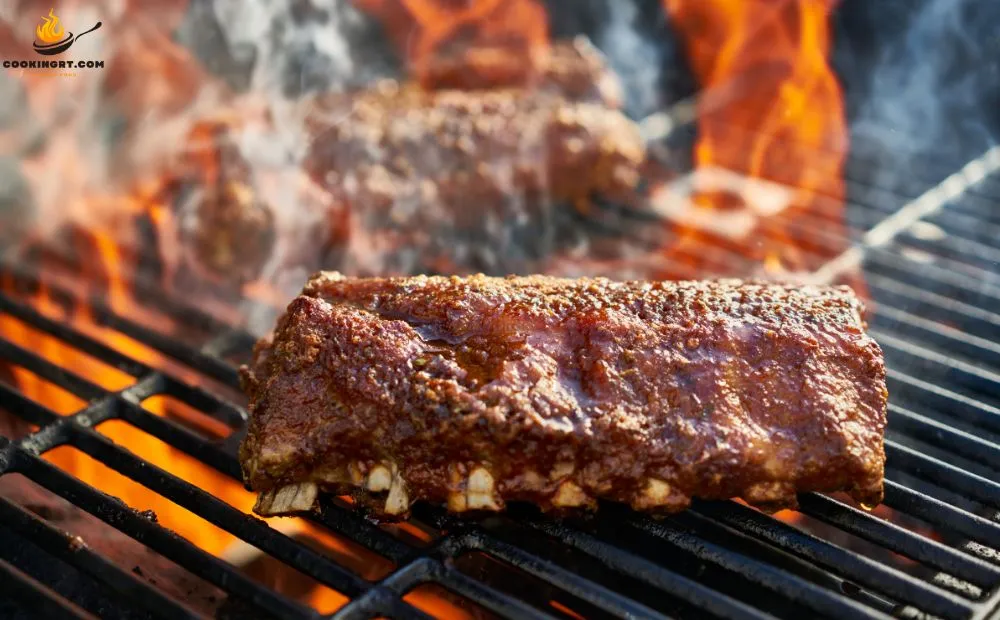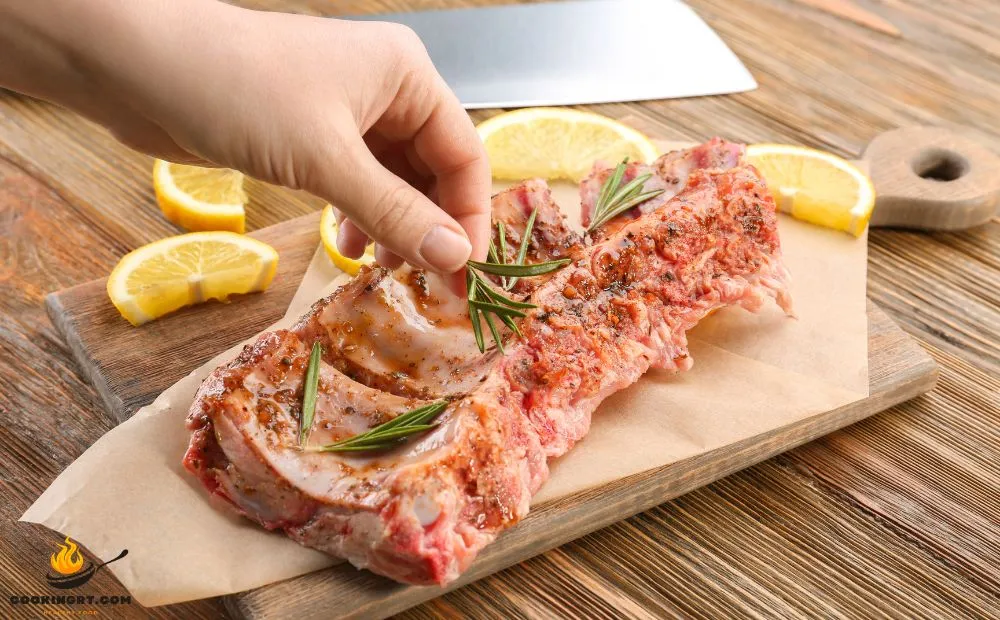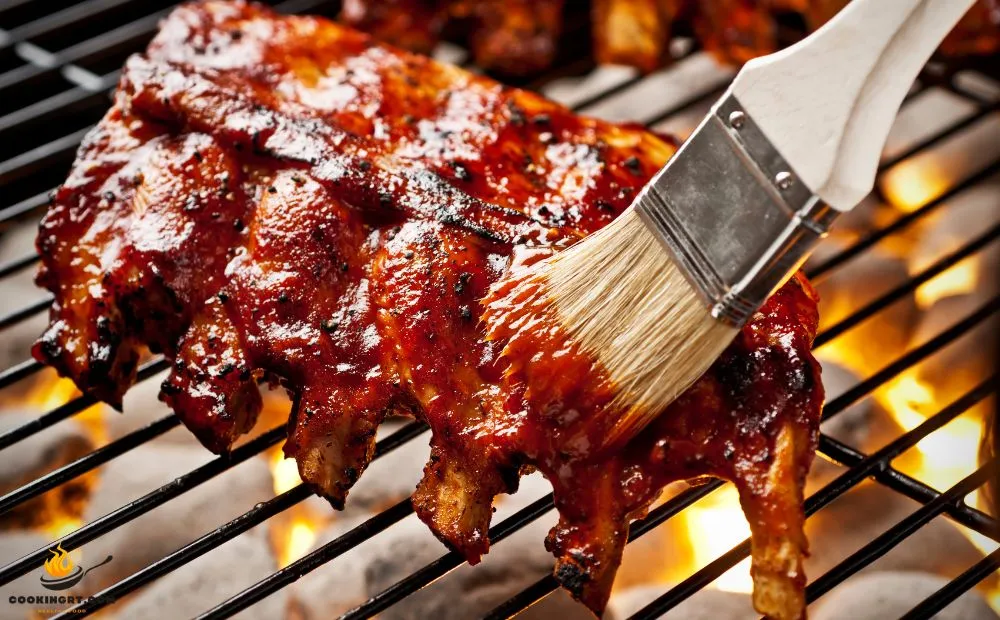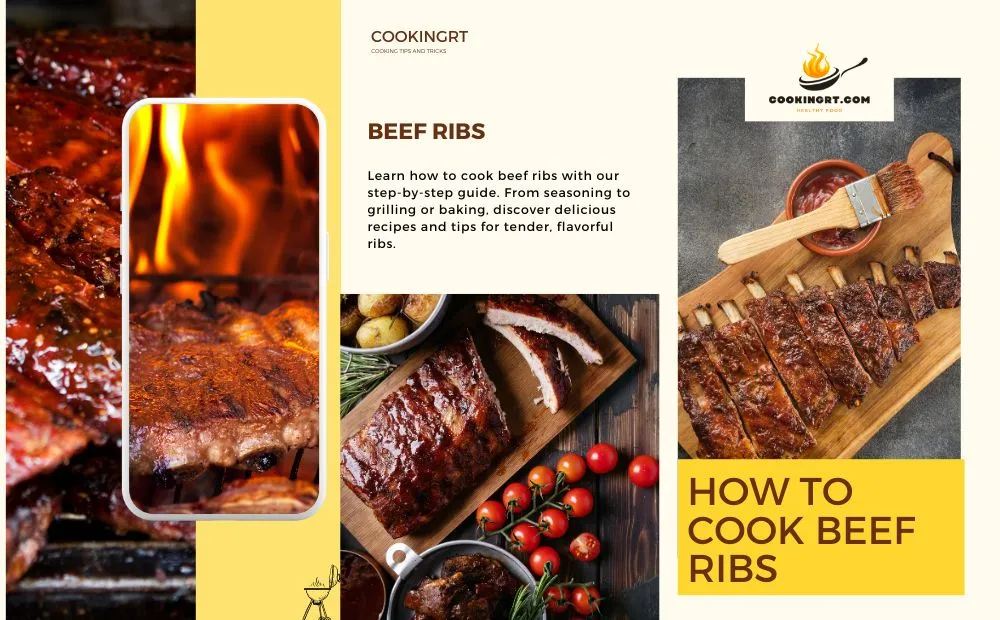Beef ribs are a classic favorite for many meat lovers, offering a rich, flavorful experience that’s hard to beat. Whether you’re planning a summer barbecue, a family dinner, or simply craving some hearty comfort food, knowing how to cook beef ribs to perfection is an essential culinary skill. In this guide, we’ll walk you through everything you need to know, from selecting the best cuts to mastering various cooking techniques, ensuring your beef ribs are always tender, juicy, and bursting with flavor.
Choosing the Right Ribs

Choosing the right ribs largely depends on personal preference and the cooking method you plan to use. Here are some common types of ribs and considerations for each:
Types of Beef Ribs
There are several types of beef ribs, each offering slightly different flavors, rib tips and characteristics. Here are the main types:
Short Ribs
Short ribs, as the name suggests, are shorter in length compared to other beef ribs. They are taken from the plate, located along the lower section of the rib cage, or the chuck, found around the shoulder area of the animal. Key characteristics include:
- Meatiness: Short ribs are prized for their substantial meat content surrounding the bone. This meat is often richly marbled, providing a succulent and flavorful eating experience.
- Cut Variations: Short ribs are available in two main styles: flanken cut and English cut. Flanken style involves cutting across the bone, resulting in thin strips with multiple pieces of bone. English style, on the other hand, entails cutting parallel to the bone, typically yielding longer pieces of meat with a single bone per piece.
- Cooking Methods: Due to their higher fat content and connective tissue, short ribs are best suited for cooking methods that involve low and slow heat, such as braising, slow cooking, or smoking. This allows the fat and collagen to render, resulting in tender, melt-in-your-mouth meat.
Back Ribs
Back ribs, also known as dinosaur ribs, are extracted from the rib section closer to the spine, particularly the upper part of the rib cage. Here’s what sets them apart:
- Leanness: Compared to short ribs, beef back ribs are relatively leaner, with the meat primarily located between the bones rather than on top.
- Cut Description: Back ribs are typically sold in two forms: individual ribs or racks. Individual dino ribs offer versatility in portioning, while racks present an impressive centerpiece for grilling or smoking.
- Cooking Methods: Back ribs lend themselves well to quicker cooking methods such as grilling or smoking. Their leanness allows them to cook relatively swiftly while still retaining moisture and tenderness. They can also be basted or marinated to enhance flavor during cooking.
Quality of Meat
Ensuring the quality of beef spare ribs is paramount for a satisfying culinary experience. Here’s what to look for:
- Marbling: Look for beef ribs with ample marbling, which refers to the intramuscular fat distributed throughout the meat. Marbling contributes to flavor, juiciness, and tenderness. Opt for cuts with fine streaks of fat evenly distributed within the muscle tissue.
- Color: Fresh beef ribs should exhibit a vibrant, cherry-red hue. Avoid cuts that appear dull, discolored, or have a brownish tint, as these may indicate age or improper storage. Additionally, steer clear of any meat with a greenish tinge, as it signals spoilage.
- Smell: Give the beef ribs a sniff; they should have a neutral or slightly sweet aroma. Any off-putting odors, such as a sour or ammonia-like smell, are red flags indicating spoilage or bacterial growth.
- Grade: Consider the USDA beef grades or equivalent grading systems in your region. Prime-grade beef offers the highest level of marbling and tenderness, followed by Choice and Select grades. While Prime-grade beef is ideal for luxurious dining experiences, Choice-grade beef provides excellent flavor and tenderness at a more affordable price point.
Quantity to Buy
Determining the appropriate quantity of giant beef ribs ensures that you have enough to satisfy your guests without overindulging. Here’s how to calculate:
- Per Person Serving: Plan to purchase approximately 1 pound (450 grams) of beef ribs per person. This accounts for the weight of the bones and ensures each guest receives an ample portion of meat.
- Event Type: Consider the nature of your gathering when estimating quantities. For casual barbecues or gatherings where guests may have heartier appetites, you might want to slightly increase the amount of ribs purchased. Conversely, for more formal dinners with multiple courses, the standard serving size may suffice.
- Leftovers: If you anticipate having leftovers or if you intend to repurpose the ribs for future meals, it’s advisable to purchase extra. Leftover ribs can be reheated and enjoyed later or used in a variety of dishes such as soups, stews, or tacos.
- Bone-in vs. Boneless: Keep in mind that bone-in ribs will weigh more due to the presence of bones. If opting for boneless ribs, you may require slightly less weight per person since there are no bones to account for. Adjust your quantity accordingly based on the type of ribs you choose.
Preparing the Ribs

Trimming Excess Fat:
Trimming excess fat involves carefully cutting away any visible fat from the surface of the ribs. This step not only improves the appearance of the ribs but also prevents flare-ups during cooking and allows the flavors to penetrate the meat more effectively. Use a sharp knife to gently trim the fat, being careful not to remove too much meat in the process. Aim to create a uniform layer of fat for even cooking and optimal flavor.
Removing the Membrane:
The membrane, also known as the silver skin, is a tough and chewy layer that covers the bone side of the ribs. Removing this membrane is essential for tenderizing the meat and enhancing the flavor absorption during cooking. To remove the membrane, start by sliding a butter knife or your fingers under the edge of the membrane to loosen it from the bone. Once loosened, grip the membrane with a paper towel for better grip and peel it off in one swift motion. Take care to remove the entire membrane to ensure a more enjoyable eating experience.
Seasoning the Ribs
Sure, here’s a breakdown of each method for seasoning ribs:
Dry Rubs
Dry rubs are mixtures of dry herbs, spices, sugars, salt, and sometimes other flavorings like garlic or onion powder. These rubs are applied directly onto the surface of the ribs, covering them evenly before cooking. Dry rubs form a flavorful crust during cooking, enhancing the taste and texture of the meat. They can be customized according to personal preference, allowing for a wide range of flavor profiles, from sweet and smoky to spicy and tangy.
Marinades
Marinades are liquid mixtures typically consisting of acidic ingredients like vinegar, citrus juice, or wine, combined with oil, herbs, spices, and sometimes sweeteners like honey or sugar. Ribs are soaked in the marinade for several hours or overnight, allowing the flavors to penetrate the meat and tenderize it. Marinades not only infuse the ribs with flavor but also help to break down connective tissues, resulting in more tender and juicy meat. However, it’s essential to avoid over-marinating, as prolonged exposure to acidic ingredients can make the meat mushy.
Brining
Brining involves soaking the ribs in a solution of water, salt, and sometimes sugar or other seasonings. This method helps to add moisture and flavor to the meat while also tenderizing it. The salt in the brine penetrates the meat, allowing it to retain more moisture during cooking, which can prevent dryness, especially in lean cuts of meat like ribs. Additionally, brining can enhance the natural flavors of the meat and create a juicier, more succulent final product. Brining times can vary depending on the size and thickness of the ribs, but typically range from a few hours to overnight in the refrigerator.
Cooking Methods
Sure, here are definitions for each cooking method:
- Smoking: Smoking is a cooking process that involves exposing food, often meat or fish, to smoke from burning or smoldering material, such as wood chips, for flavoring, preserving, or cooking. The smoke infuses the food with a distinctive aroma and flavor while also helping to preserve it by inhibiting bacterial growth. Smoking can be done using various types of wood, each imparting its unique flavor profile to the food.
- Grilling: Grilling is a cooking method that involves cooking food over direct, dry heat, usually on a or griddle. This method is commonly used for meats, vegetables, and seafood. Ribs on the grill typically imparts a charred, smoky flavor to the food due to the direct contact with the heat source. It’s a fast cooking method, often used for outdoor cooking, and it’s known for producing flavorful, slightly caramelized results.
- Oven-Baking: Oven-baking is a cooking method that involves cooking food by surrounding it with dry heat in an enclosed space, typically an oven. This method is commonly used for baking bread, cakes, cookies, casseroles, and roasting meats and vegetables. The dry heat cooks the food evenly from all sides, resulting in a uniform texture and golden-brown crust in baked goods. Oven-baking is versatile and allows for precise temperature control, making it suitable for a wide range of recipes.
- Slow Cooking: Slow cooking, also known as crock-pot cooking or simmering, is a method that involves cooking food at a low temperature over an extended period. This method is often used for tough cuts of meat, soups, stews, and sauces. Slow cooking tenderizes meat and allows flavors to meld together over time, resulting in rich, flavorful dishes. It’s convenient for busy days since it requires minimal hands-on preparation and can be left to cook for hours unattended, yielding delicious, melt-in-your-mouth results.
Smoking Beef Ribs

Smoking beef ribs is a fantastic way to impart delicious smoky flavors while achieving tender, juicy meat. Here’s a general guide on how to smoke beef ribs:
Equipment Needed
Smoker: You can use a traditional offset smoker, a pellet smoker, or an electric smoker. Each type offers different advantages, but they all work well for beef ribs.
Fuel: Depending on your smoker, this could be hardwood chunks, pellets, or charcoal. Hickory, oak, and mesquite are popular choices for beef smoked ribs.
Thermometer: A reliable meat thermometer is essential for monitoring the internal temperature of the ribs.
Knife and Cutting Board: For preparing the ribs before smoking.
Rib Rack: Optional but helpful for maximizing space in your smoker.
Wood Chips or Chunks: To add flavor. Common choices include hickory, oak, apple, and cherry.
Spray Bottle: For moistening the ribs during the smoking process.
Aluminum Foil or Butcher Paper: For wrapping the ribs during the cooking process to help retain moisture.
Basting Brush: For applying sauces or marinades.
Drip Pan: To catch any drippings and make cleanup easier.
Setting Up the Smoker
- Select Your Wood: Choose wood chips or chunks based on the flavor you want to impart. Hickory and oak are robust, while fruitwoods like apple or cherry offer a milder, sweeter flavor.
- Preheat the Smoker: Start by lighting your smoker and bringing it to a stable temperature between 225°F and 250°F (107°C and 121°C). This low and slow cooking temperature is ideal for beef ribs.
- Add Wood: Once the smoker is preheated, add your selected wood chips or chunks. If using an electric smoker, follow the manufacturer’s instructions for adding wood.
- Set Up Drip Pan: Place a drip pan filled with water, apple juice, or a mixture of both beneath where the ribs will sit. This helps maintain moisture and catches any drippings.
- Adjust Vents: Control the airflow to stabilize the temperature. Open vents increase temperature and airflow, while closed vents lower the temperature.
Smoking Process
Smoking beef ribs is an art that transforms a tough cut of meat into a succulent and flavorful dish. Here’s a guide to help you achieve perfect smoked beef ribs.
- Prepare the Ribs: Trim any excess fat and remove the silver skin from the ribs. Season generously with a dry rub of your choice. Common ingredients include salt, pepper, paprika, garlic powder, and brown sugar.
- Place the Ribs in the Smoker: Position the ribs bone side down on the grates. If using a rack of beef ribs, place them upright.
- Maintain Moisture: Every hour, spritz the ribs with a mixture of apple juice and water using a spray bottle. This keeps the meat moist and adds flavor.
- Monitor Temperature: Use your meat thermometer to check the internal temperature of the ribs. Aim for an internal temperature of around 203°F (95°C) for tender ribs.
- The Texas Crutch: After about 3-4 hours, once the ribs have developed a nice bark, consider wrapping them in aluminum foil or butcher paper. This technique helps retain moisture and speeds up the cooking process.
- Finish Unwrapped: In the last hour of smoking, unwrap the ribs to let the bark firm up again.
- Rest the Ribs: Once the ribs reach the desired internal temperature, remove them from the smoker and let them rest for at least 15-20 minutes. This allows the juices to redistribute throughout the meat.
Grilling Beef Ribs

Grilling beef ribs can be a delicious endeavor, requiring attention to both direct and indirect heat methods for optimal results. Begin by preheating your grill, setting up one side for direct heat and the other for indirect heat. Season your beef plate ribs generously with your preferred rub or marinade, allowing them to sit at room temperature for about 20-30 minutes before grilling. Place the bbq ribs over direct heat initially, searing each side for 3-4 minutes to achieve a caramelized crust. Then, move the ribs to the indirect heat side, positioning them bone-side down for slower, more even cooking. Close the grill lid and cook for about 1.5 to 2 hours, maintaining a grill temperature around 225-250°F (107-121°C).
Use a meat thermometer to ensure the ribs reach an internal temperature of 190-203°F (88-95°C) for tender, juicy results. Throughout the grilling process, resist the temptation to constantly flip the ribs to retain moisture and flavor. To enhance flavor, periodically baste the ribs with a mop sauce or apple cider vinegar mixture. Once done, let the ribs rest for 10-15 minutes before slicing and serving. These steps ensure perfectly grilled beef ribs, tender on the inside with a smoky, caramelized exterior, ready to delight your guests or family.
Also, Read More: Is A Burger A Sandwich?
Oven-Baking Beef Ribs
Oven-baking beef ribs is a great way to achieve tender, flavorful ribs without needing a grill or smoker. Here’s a basic guide to oven-baking bbq beef ribs:
Preheating the Oven
To begin oven-baking beef ribs to tender perfection, start by preheating your ribs in the oven to an optimal temperature of 300°F (150°C). This initial step ensures that the ribs cook evenly and retain moisture throughout the baking process.
Baking Techniques
Once the oven reaches the desired temperature, place the beef chuck ribs on a foil-lined baking sheet or in a baking dish. This method helps to contain juices and simplify cleanup afterward. For even cooking, it’s advisable to space the ribs apart on the baking surface, allowing hot air to circulate around each piece.
Foil-Wrapping (Texas Crutch)
For a Texas-style twist, consider using the foil-wrapping technique, also known as the Texas Crutch. Around halfway through the cooking time, typically after about 1.5 to 2 hours, tightly wrap the ribs in aluminum foil. This step helps to lock in moisture and tenderness while infusing the meat with flavor. You can add a splash of apple juice or barbecue sauce inside the foil for extra moisture and taste.
By following these steps—preheating the oven, employing proper baking techniques, and using the foil-wrapping method—you’ll achieve succulent, fall-off-the-bone beef dino ribs that are sure to impress. Adjust cooking times based on the thickness of the ribs and desired level of tenderness, and remember to let the ribs rest for a few minutes after baking to allow the juices to redistribute evenly before serving.
Slow Cooking Beef Ribs
Slow cooking dino ribs beef in a crockpot can yield tender, flavorful results that are worth the wait. Here’s how to do it effectively:
Using a Slow Cooker
Begin by preparing your beef ribs—whether they’re short ribs or back ribs, trimming excess fat can enhance the final dish. Season the ribs generously with salt, pepper, and any preferred spices or rubs. Searing the ribs in a hot skillet beforehand can add depth to the flavor by caramelizing the surface and locking in juices. Place the ribs into the slow cooker, arranging them so they fit snugly but are not overcrowded.
Cooking Times
Cooking times can vary based on the size and cut of the ribs. For tender short ribs, set your slow cooker to low for 6-8 hours or on high for 4-5 hours. Back ribs might require a slightly shorter cooking time—approximately 5-6 hours on low or 3-4 hours on high. The ribs are done when the meat is tender and easily pulls away from the bone.
Enhancing Flavor
To enhance the flavor profile, consider adding aromatic vegetables such as onions, garlic, and celery to the slow cooker. A splash of broth, wine, or a combination of both can create a flavorful cooking liquid. Additionally, adding a few tablespoons of Worcestershire sauce, soy sauce, or balsamic vinegar can further enrich the taste. About halfway through cooking, baste the ribs with the cooking juices to keep them moist and flavorful.
Conclusion
Mastering the art of cooking beef ribs can turn an ordinary meal into a memorable feast. Whether you prefer slow-cooking for tender, fall-off-the-bone meat or grilling for that perfect char and smoky flavor, understanding the techniques and nuances of each method is key. From seasoning to temperature control, every step contributes to the final masterpiece. So, the next time you’re ready to impress friends and family with your culinary prowess, remember these words: How To Cook Beef Ribs. With practice and a passion for good food, you’ll soon be serving up pork ribs that rival those of any top barbecue joint.
Frequently Asked Questions (FAQ’s)
Q: What are beef ribs?
Ans: Beef ribs come from the rib section of the cow and are known for their rich flavor and tender meat. They can be either back ribs (from the rib section closer to the spine) or short ribs (from the lower rib section closer to the belly).
Q: Should I choose back ribs or short ribs for cooking?
Ans: Both back ribs and short ribs are delicious, but they have different textures and flavors. Back ribs are leaner and have a meatier texture, while short ribs have more marbling and connective tissue, making them tender and juicy when cooked low and slow.
Q: How do I prepare beef ribs before cooking?
Ans: Before cooking beef ribs, it’s important to trim excess fat and membrane from the ribs if needed. This helps the seasoning and flavors penetrate better and ensures a more enjoyable eating experience.
Q: What are some seasoning options for beef ribs?
Ans: Beef ribs can be seasoned with a variety of rubs or marinades. Common seasonings include salt, pepper, garlic powder, onion powder, paprika, chili powder, and brown sugar. Experimenting with different spice blends can add depth to the flavor profile.
Q: How long does it take to cook beef ribs?
Ans: Cooking times can vary depending on the method and the size of the ribs. Generally, beef ribs cooked low and slow can take anywhere from 2 to 6 hours. Short ribs may take longer due to their higher collagen content that needs time to break down and tenderize.
Q: How can I tell when beef ribs are done?
Ans: Beef ribs are done when the meat is tender and easily pulls away from the bone. For back ribs, this may be indicated by a slight pullback from the bone ends. For short ribs, a fork should easily pierce through the meat without resistance.

